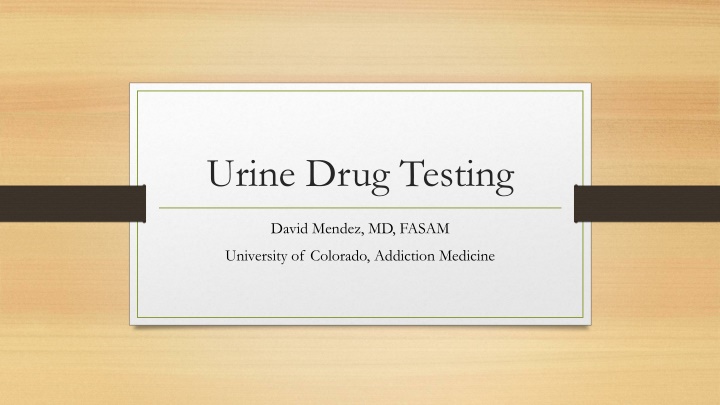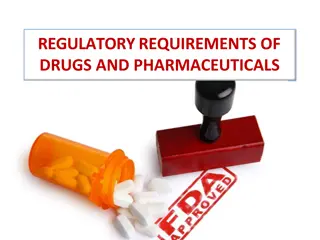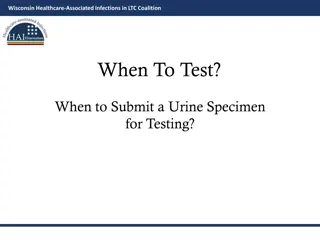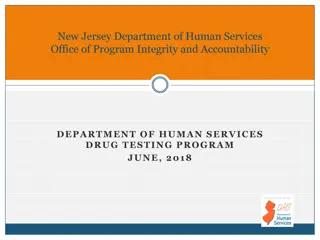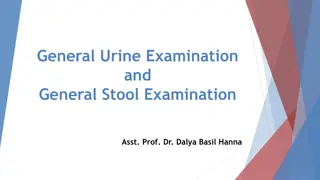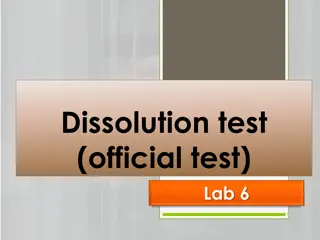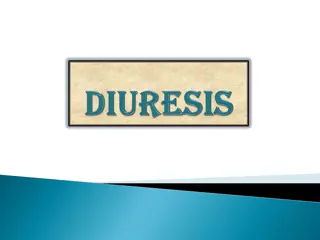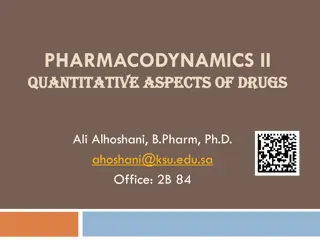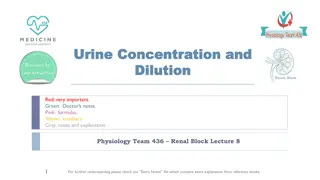Urine Drug Testing: Learn Differences, Techniques, and Limitations
The nuances of urine drug testing, including the variances between presumptive and definitive tests, the use of immunoassays, detection windows for substances, testing schedules, and common false positives. Understand the complexities and considerations involved in this critical aspect of healthcare.
Download Presentation

Please find below an Image/Link to download the presentation.
The content on the website is provided AS IS for your information and personal use only. It may not be sold, licensed, or shared on other websites without obtaining consent from the author.If you encounter any issues during the download, it is possible that the publisher has removed the file from their server.
You are allowed to download the files provided on this website for personal or commercial use, subject to the condition that they are used lawfully. All files are the property of their respective owners.
The content on the website is provided AS IS for your information and personal use only. It may not be sold, licensed, or shared on other websites without obtaining consent from the author.
E N D
Presentation Transcript
Urine Drug Testing David Mendez, MD, FASAM University of Colorado, Addiction Medicine
Objectives Define the difference between presumptive and definitive tests. Describe immunoassays and how they cross react with differing substances. Learn the windows of detection for various substances. Understand testing schedules for urine drug testing and how this can apply in your practice.
Definitive tests (typically chromatography/mass spectrometry) Presumptive tests (typically immunoassays): Useful if testing will inform a decision with major clinic/non- clinical implications Faster turnaround, faster therapeutic response Tend to be point of care Lower sensitivity and/or specificity Tend to be laboratory based Used as confirmatory testing
Immunoassays Use antibodies to bind to a specific substance Detect specific targets - class of drugs, parent substance, or a metabolite Varying degrees of sensitivity and specificity A certain amount of substance, or cut off value , to be detected as positive Lower cost May show up negative if not enough substance in one s system Negative results may not exclude the presence of a substance
Limitations of immunoassays Major limitation = cross reactivity Antibody may interact with substances other than the target substance Variable sensitivities for different substances within a class
Chromatography/mass spec Gold standard: chromatography combined with mass spec Chromatography: separates substances into components Mass spec: identifies actual substance Highly sensitive and specific Can be useful in: Confirming a positive result on an immunoassay Identify a specific substance within an immunoassay Detect a substance that was not detected in an immunoassay if it was expected
Common false positives Amphetamines LOTS Bupropion Ephedrine Fluoxetine Labetalol Phentermine Propranolol Ranitidine Trazodone Vicks vapor rub
Benzodiazepines Oxaprozin sertraline Opiates Quinolones Rifampicin poppy seeds
Positive result does not diagnose a substance use disorder and a negative result does not rule one out
Amphetamines Usually targeted substance is methamphetamine Many false positives due to cross reactivity Can also cross react with MDMA Window of detection: 1-3 days Immunoassays
Benzodiazepines Complex immunoassay due to diverse metabolites Many benzodiazepines have poor cross reactivity with common immunoassays High false negative results Most immunoassays have low sensitivity and specificity to clonazepam and lorazepam Will vary manufacturer to manufacturer Window of detection: 3 days Immunoassays
Opiates/opioids Understand which substance your immunoassay tests for Semi-synthetic or synthetic opioids may not be tested in an immunoassay testing for opiates Standard opiate immunoassay tests for: heroin, codeine, morphine, hydrocodone (+/-) Oxycodone might be detected but not detected in most Not detected: meperidine, fentanyl, methadone, buprenorphine Window of detection: 1-3 days Immunoassays
Cocaine Tests for metabolite benzoylecgonine Unlike the other presumptive tests, more specific and sensitive Window of detection: 3-5 days Immunoassays
Cannabis Window of detection = Light use: 2 days; Heavy use: 30 days Highly lipophilic and stored in fat tissues Most measure inactive metabolite Positive test does not correlate with level of impairment Oral ingestion of hemp and dronabinol would show a false positive Immunoassays
Immunoassays 1 2 3 Should be used to support recovery, not as punishment Provider s response to test results should not be confrontational Lots of cross reactivity with immunoassays, if unknown, confirm
Very little guidance as to whats effective Higher acuity/level of care, potentially increase frequency of testing Test Scheduling Provider s therapeutic questions should guide testing Data does not show that more testing leads to decrease substance use
Can start with a risk screener and stratify based on risk ORT-OUD, SOAPP-R
Take away points Presumptive tests (immunoassays) vary in specificity and sensitivity and should be confirmed if it will dictate a clinical decision It s important to understand which substances your immunoassay detects more reliably, specifically for opioids and benzodiazepines. Immunoassays have cross reactivity with various substance which may cause false positives. Testing schedule will depend on provider and vary depending on patient. Utilize what works for you.
References Miller, SC, Fiellin, DA, Rosenthal, RN, Saitz, R. The ASAM principles of Addiction Medicine. 6thEdition Consensus statement: Appropriate use of Drug testing in clinical addiction medicine. 2017. Urine drug screening: a guide to monitoring tx with controlled substances. 2021. Journal of family practice.
